Vitamin C is one of the few skincare ingredients with a decent amount of independent research to back up its properties, like its brightening and anti-wrinkle benefits.
Related Post: Vitamin C – what does it do for your skin?
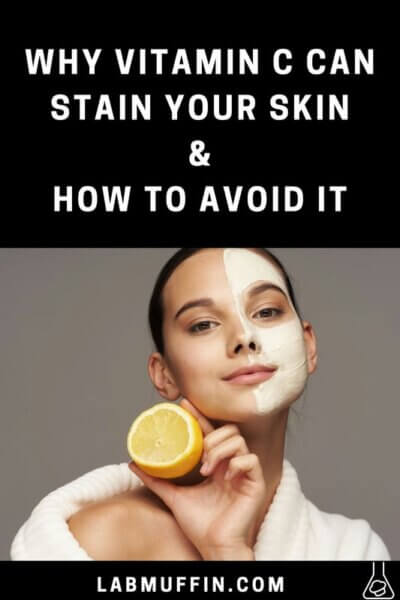
But those of you who are vitamin C enthusiasts may have noticed that with some vitamin C serums that contain ascorbic acid, you end up with slightly darkened skin after a few days of use. The stained skin looks red or orange-brown, sort of like fake tan. It can happen on your face, as well as your hands and fingernails. It can even stain your hair orange!
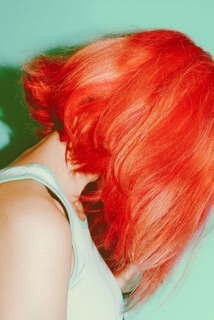
I’ve often wondered why this happens, but I didn’t really dig into it past a quick Google search (which found nothing), so I just put it off as a weird side effect of vitamin C oxidising.
But recently, I came across a diagram in a peer-reviewed paper on a completely different topic that accidentally told me exactly why vitamin C does this: ascorbic acid eventually oxidises to erythrulose!
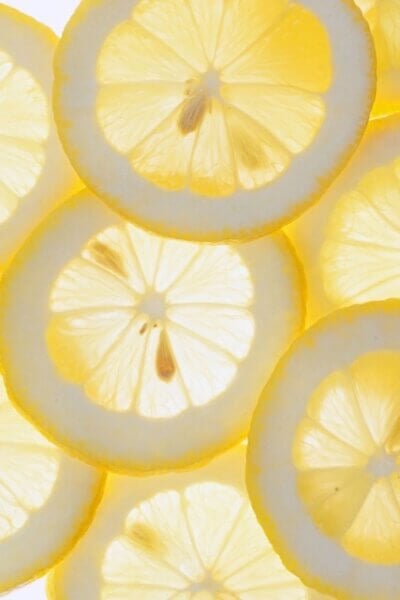
Ascorbic acid oxidation
As you may already know, vitamin C in the form of ascorbic acid (specifically L-ascorbic acid) oxidises easily. This is when it decomposes and turns into a number of other substances that likely have much less benefits for skin, and it gradually darkens in colour during this process.
Ascorbic acid oxidises in products, especially when it’s in the presence of water, as well as on your skin. Oxygen and light exposure will also speed up the oxidation reaction.
The first step in the oxidation process is when the ascorbic acid is converted to dehydroascorbic acid. This reaction is reversible, so you can get back the ascorbic acid if you have the right antioxidants in the formula.
However, dehydroascorbic acid also decomposes, and this process is irreversible. It turns into a number of different substances, but for our purposes here, we only care about the fact it turns into 2,3-diketogulonic acid, which then turns into erythrulose, according to the reactions I’ve drawn below:
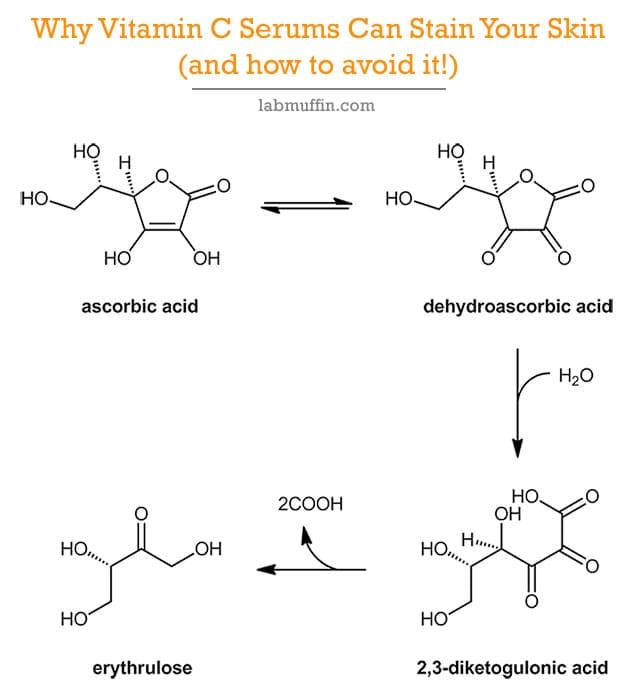
Erythrulose is an ingredient in fake tans, and is often included alongside the more commonly found dihydroxyacetone or DHA.
These ingredients work by reacting with proteins in the dead stratum corneum layer of your skin to produce brown compounds called melanoidins. These melanoidins stay on your skin and give it a brown colour, until the dead cells slough off (after around a week).
The reaction is a Maillard reaction, similar to the reactions that happen when meat and baked goods turn brown with heat.
Related post: The Science of How Fake Tan Works
Erythrulose is notable for giving a slightly redder tan than DHA. It stains more slowly, less streakily and lasts longer.
It’s included in tans from Isle of Paradise, St Tropez, Tan-Luxe, Jergens and Dove that have DHA as the main ingredient. It’s also the sole ingredient in Deciem’s Chemistry Glow Oil and Hylamide Glow Radiance Booster.
So that’s why vitamin C serums can stain – the ascorbic acid essentially turn into fake tan on your skin! And you’ll notice that it has that signature soy sauce-like fake tan smell too.
Mystery solved!
How to Avoid Vitamin C Staining Your Skin
So now that we know why vitamin C serums can stain, how can we prevent this from happening?

There are a few approaches:
Prevent oxidation
Preventing the vitamin C from oxidising is the obvious way of keeping the erythrulose levels down in the first place.
You can use an antioxidant-rich formulation like the classic trio of vitamin C, vitamin E and ferulic acid (e.g. Skinceuticals, Timeless or Paula’s Choice). These extra antioxidants can act to undo the initial, reversible step of the oxidation process (ascorbic acid → dehydroascorbic acid) both in the bottle and on your skin.
Related post: Ultimate Vitamin C Skincare Guide Part 1: Ascorbic Acid (with video)
After applying any ascorbic acid product (like my low-tech, budget-friendly DIY vitamin C serum), it can be helpful to immediately use oils and creams on top, to try to protect the vitamin C from the air until it absorbs into the skin.
Related Post: Easy (5 Minute) DIY Vitamin C Serum Recipe
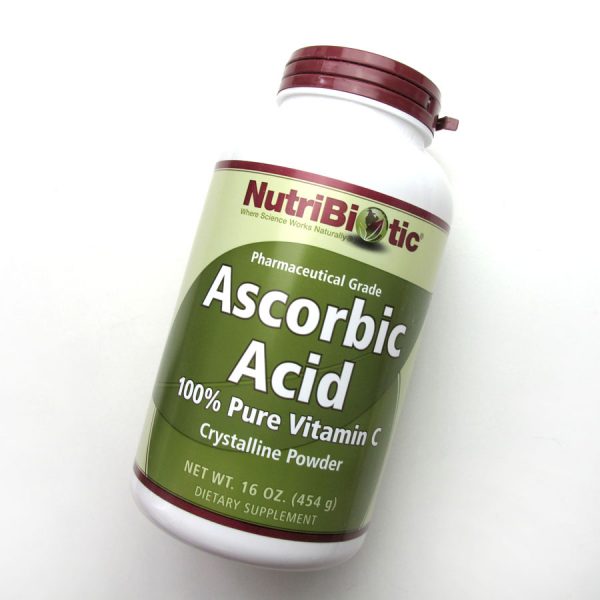
Using vitamin C at night, away from high energy sunlight, will also help prevent accelerated oxidation.
Related post: Water-Based Vitamin C Serums
Use oxidation-resistant forms of vitamin C
Ascorbic acid is by far the most unstable form of vitamin C, and oxidises very easily. However, it’s the best researched form vitamin C ingredient in terms of its benefits on the skin.
The other forms of vitamin C (vitamin C derivatives) aren’t as well researched, and require your skin to take a few extra steps to convert it to an active form before working, but they have one big advantage – they won’t oxidise anywhere near as badly on your skin, and should cause much less staining!
Some of these oxidation-resistant vitamin C ingredients include:
- magnesium ascorbyl phosphate (e.g. from The Ordinary)
- sodium ascorbyl phosphate
- ascorbyl tetraisopalmitate (also known as tetraisopalmitoyl ascorbic acid or ATIP, e.g. again from The Ordinary, who seem to have every variation of vitamin C)
- tetrahexyldecyl ascorbate (THDA, which seems to be the same as ATIP but with a different name for some reason e.g. from Sunday Riley, Medik8)
Related post: Vitamin C Esters: Are ATIP and THDA the Same Thing?
Wash your hands after applying vitamin C serums
Fake tan ingredients stain dead skin cells, and your hands tend to have a thicker stratum corneum than your face, particularly around your nails. This means that sometimes your hands will turn brown even if your face doesn’t noticeably stain!
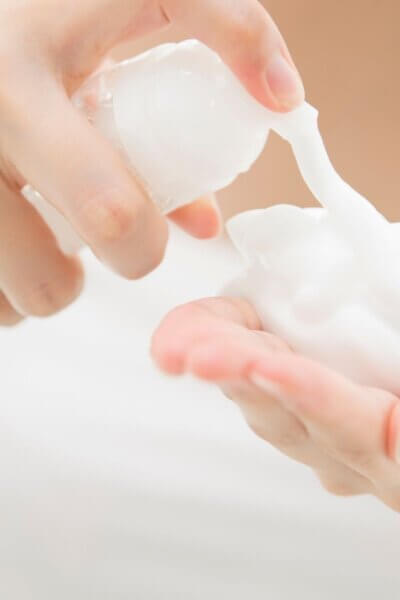
Your nails also contain keratin, which can also participate in these browning reactions.
To avoid stained hands and nails, just wash them with soap immediately after applying the vitamin C serum. And make sure you scrub them thoroughly!
Apply vitamin C serum evenly over face
Some of you might not mind the colour – it can actually give you a nice rosy glow, which is why a lot of people use fake tan!
If that’s you, then just apply the serum as evenly as possible. Also make sure that you regularly exfoliate your face so the dead skin layer is even and the tan stains uniformally, and fades evenly.
If you notice streaking, it might be due to a later product moving the erythrulose around on your skin. You should be able to reduce the chances of this happening by increasing the waiting time between applying vitamin C serum and your next product – try half an hour as a starting point.
This post contains affiliate links – if you decide to click through and support Lab Muffin financially (at no extra cost to you), thank you! For more information, see Disclosure Policy.





What about The Ordinary’s Ascorbyl Glucoside solution? I mix this in the AM with their ferulic acid/resveratrol serum and a drop of hyaluronic acid…
It should be oxidation-resistant! 🙂
Very interesting post!
Is Erythrulose bad for skin? Does oxidation mean, that it accelerates ageing of the skin?
Nope! It isn’t bad for skin – it might increase free radicals while you’re in the sun by a tiny amount if it’s like DHA, but it’ll be insignificant.
Super interesting and helpful. My cerave vit C serum turns orange around my hairline… perhaps where I’m not applying my skin cream with SPF 30 as diligently as other parts of my face. Will have to do better!
Thanks so much for this post! I’ve been having this issue with the 23% Vitamin C from the Ordinary and I always have the impression that it makes my hands smell like self-tanner, now I know why! 🙂
I don’t really mind the staining too much (tbh I kind of like the smell), but what really makes me worry is: when the Vitamin C oxidizes on my skin, does it form free radicals there and possibly cause more harm than good and eventually really damages the skin?
There’s a low chance, but no one really knows – it seems that unstabilised Vit C serums still have good results in studies so overall it looks like it ends up being a net positive 🙂
i think as Michelle have mentioned, if you want to be extra careful about it you can mix it in with other antioxidants to keep the vitamin C stable. you’ll get extra benefits from it anyway
I never had that happen, at least not to a point where I did notice, but it certainly is interesting.
I’ve only had it happen a couple of times to my fingertips!
It’s all over both of my thumbs for the past week. It looks like I got stained with Cheetos. And I have a red carpet event I’m
To attend tonight in NYC. Smh!
How long do you think stain will last – I have noticed my whole face turning more orange but couldn’t pinpoint why. I plan to stop the vitamin c serum now.
Same as fake tan – it’d depend on how often you exfoliate and how quick your skin turnover is, but in general less than a week.
Yes, I did notice the tint on my nail bed and cuticle area. I recently added an additional vitamin c. the old one never tinted. Now, one of the ones you mentioned was added and I have the tint. Glad to know why. Thank you.
Glad I could help solve that mystery! 🙂
I had this happen with Ole Henriksen Truth Serum, but it didn’t stain evenly – mostly around the “marionette lines”. None of the other Vit C serums have done it – so good to know what was happening, it kind of freaked me. I always smile when I see Maillard Reaction, I did my biochemistry paper on it some 33 years ago. Who would have thought we’d be using it for fake tans – lol- back in the day when it was fashionable to bake in the sun slathered with baby oil.
Haha I didn’t think I’d ever see the Maillard reaction again after a molecular gastronomy lecture I went to once… how wrong I was!
This is so interesting! I had no idea ! Such a great extensive blog post 🙂
Thank you! 🙂
Ha! I do not mind it at all.
I haven’t minded it so far, but I’m also a bit irregular with my vitamin C usage -_-
Sorry this is off topic but can I use two different types of vitamin c( indeedlabs vitc24 and TO ascorbyl glucosidr)?
Should be fine 🙂
Hi, Michelle!
I had a quick nail polish question for Google at about a quarter to midnight, which led me to your blog. It’s now nearly four in the morning, and I’m forcing myself to stop reading and go to bed.
You’ve completely hooked this lipstick-obsessed nerd’s heart and mind! Thank you!
Hahaha that’s fantastic! Thank you! 😀
I’ve noticed my skin turning brownish-red and my palms being a bit more tanned. i thought it was odd, but I’ve realized it could probably be the vitamin C oxidising! I’ve noticed this on Paula Begoun’s palms as well, and she likes to use her vitamin C. i don’t know the mechanisms to it but thanks to you, now I know why! you’re brilliant and you’ve helped everyone a lot with your bite sized research! thank you Michelle.
Hi Michelle,
What do you think of a serum with 12% LAA and 88% butylene glycol (e.g. CSI serum)?
Is this a stable formula?
Thank you
Anna
Hey Michelle! Do darker skin tones (I’m a dark skin African American ) have to worry about this staining? I certainly haven’t noticed any tanning of my skin, but I have noticed that it’s brighter! I was just wondering if it was different for people with my type of skin. Thanks (:
It probably won’t be very noticeable on your skin 🙂
used my usual skincare incorporating vitamin c (c21.5 by wishtrend) and vitamin e, and a zinc sunscreen (no makeup) and when removing with makeup remover i noticed the gunk i was wiping off was yellowy.
i’m assuming this means it oxidized on my skin? (it’s kept in the fridge usually and the solution is not yellow)
PHEW! Great article! I just started using a vit. c serum and was disturbed by this phenomenon. I was mostly concerned I had a bad batch, or the brand was bad or poorly made. (one of the many reasonable priced brands on amazon similar to Timeless). I was wondering if the “glow” they claim the serum will cause was a scam and it was just a tanner, masking your imperfections, making you think your skin is actually improving. I contacted the company but no response. I wonder if even they know of this explanation.
I stumbled onto your blog through your Vitamin C posts while debating the relative merits of making my own l-ascorbic serum, Drunk Elephant’s C-Firma, or venturing into tetrahexyldecyl ascorbate with Sunday Riley’s C.E.O serum. (I have Sephora gift cards and a sale that starts tomorrow, creating an odd scenario in which purchasing ingredients is actually not as cost effective as using “free money”.)
I am just a bit stymied as to what your intended meaning is by striking through “Sunday Riley” in the product links. Do you feel that her version is less effective than Medic8? Any clarification would be greatly appreciated.
Thanks in advance for any response.
I’m planning to do a post comparing different types of vitamin C soon 🙂
The strike-through just means that my link is broken – I’ve just disabled that CSS!
This caused me to give up on Vitamin C serums.
I like having light porcelain skin and do not think the fake tan looks good at all.
There are other ways to keep skin healthy from the sun and other elements (sunblock, maybe B3 etc. etc.). Also light skin allows me to see the condition of my skin better, otherwise I could miss redness and other things.
My skin has turned a darker brown due to using oxidated vitamin c serum. I ujust wanteda to know how i can remove the stain from my face
Same problem😒
Hi Michelle! I can’t tell you how much I appreciate your blog, and particularly this entry as it has solved a major mystery for me. As soon as I receive all the ingredients, I’m going to begin making a more stable DIY l-ascorbic acid based vitamin C serum for myself. In the meantime, I have a jar of The Ordinary L-Ascorbic Acid Powder, and have been mixing it with Hada Labo Premium on a daily basis to use as a serum. It’s been working great for brightening my face, but was turning my nails and fingertips the most horrid orangish-brown that looked like I was a 3-pack a day smoker! I can really scrub my hands after applying the serum, but the only thing that gets the stains off of my nails is to stop using it for a few days. I’m going to try your tip of slapping some oil on my nails after washing my hands, which will be good for my nails anyway! Thank you so much! ??
Hi Michelle,
I came to this article by way of the Well And Good blog (and also, I just started subscribing to your newsletter) and I wonder whether this could be an issue with The Ordinary Vitamin C Suspension 23%, which claims to be stable.
I haven’t noticed any staining on my fingers and I am Afro-Caribbean but I am using it as part of an anti-hyperpigmentation regimen (dark spots are a persistent problem for me), so I wonder whether I might be working against my skin’s own benefit.
What do you think?
I think it’s probably an issue (although I haven’t tried that particular product) – I haven’t tried any ascorbic acid product that doesn’t stain. The staining doesn’t contribute to hyperpigmentation, luckily!
Is there anyway to avoid staining from shirt?
as i use the ordinary vit c 23% + Ha, and it does stain my shirt badly.
use detergent cannot remove it thorougly.
Hi Michelle,
I’m new to your blog and wanted to tell you how happy I am that I found it! I start reading one post and I end up down the beautiful rabbit hole from clicking all the informative links in each post.
This post FINALLY explains why it looks like I have a perpetual tan on my face even though I slather SPF 50 zinc oxide based sunscreen daily on my face on top of my Timeless Fit C but have pale, pale skin on my neck (no Vit C just sunscreen)! I really hate the effect since it looks like I have darker foundation on my face and not my neck when I don’t have any on at all! If you have any other suggestions to lessen this sunless tanner effect, I would really appreciate it.
Do you use exfoliant? Exfoliating might help fade it faster! You could also switch to a different form of vitamin C.
Hi Michelle,
So happy to find your post when I was searching for Vitamin C forms. So does it mean ascorbyl tetraisopalmitate and tetrahexyldecyl ascorbate are different forms/molecules? Because The Ordinary Ascorbyl Tetraisopalmitate Solution 20% has Ascorbyl Tetraisopalmitate in its name but the ingredients listed only contain tetrahexyldecyl ascorbate which makes me think they are the same form. If they are different, then what are differences between them?
Thank you.
Mai.
Would you please consider doing a review on the Melanie Simon vitamin C? She claims it is incredibly stable and it is getting rave reviews and lots of publicity. Love everything you do! Xx
Hi, michelle!! This was really helpful!! Does this also happens with the ordinary 100% l-ascorbic acid powder or any brand with vit c powder?
It happens with all ascorbic acid products, including powders and serums.
Hi Michelle,
I know this is an old post and I don‘t know if you see my comment, but I LOVE your thouroughly researched but easy to understand articles! Thank you very much!
I started using a new Vitamin C Serum three weeks ago and with Corona and Home Office etc I did not bother to apply my sunscreen immediatly on top as I usually would. Now my husband noticed that I have on some days yellowy skin around my mouth and worried about my health.
After a while I had the clue that the only difference in my routine was the new serum and searched the internet fearing something could be wrong with it (albeit being perfectly clear and living in the fridge) and the only helpful resource I found was – once again – you!
I will return to my normal skincare routine and happy not to have to throw away my full bottle of Vitamin C Serum 😉
I have also faced this tan problem. Recently I have started to use vitamin c serum and cream. And then observed my skin becomes more darker.
What should I do to get rid of this problem and should I throw this serum and cream as it’s not working.?
Help help help!
I have been using the vitamin c from the inkey list and love the formula
However I have noticed the sides of my nose turn orange like a fake tan and now o finally know why ( I am guessing putting my glasses on too soon is the culprit)
More importantly I have noticed my pores look dark a d congested inside, I switched from a 10% glycolic wash to Paula’s choice for the bha thinking it would help. I also thought it was because I newly started retinol but it’s not going away. Could it have something to do with the vitamin c? I am only making the connection because that and the orange on my nose started at the same time
I tried the Ordinary’s 30% VitC suspension in silicone and had to stop using it entirely as it was getting into my pores and making them all a dark orangey brown- it was awful! It also stained my nails and cuticles, and got into very single scratch and pinprick on my fingers, making the tips of my fingers a dense constellation of tiny brown dots (I do a lot of hand sewing, which means a lot of pin pricks).
I really want to try VitC again, as I do have hyperpigmentation I’d like to fade. But I do t want stained skin. An all over stain/tanned look would be bad enough, but when it’s just pores it looks groovily! It looked like I had an orangey brown black rag in every pore! And now I’m scared to try another, because that is just not worth it! Maybe I’m better off getting the Hada Labo whitening cream instead?
I used a Vitamin C + retinol serum last night, then put moisturizer over it. I woke up this morning looking like a pumpkin. Thank you for explaining why!
I’m not a fan of the fake tan look, so this is very helpful for me. Love your tips. Thanks!
Here is my issue with TO 100% LAA: it is ruining all of my washcloths! They are now stained orange. I use plain, low cost washcloths and keep a stack of them. I single use them and then they go in the laundry. I have been applying a mix of a scoop of the 100% LAA mixed with a couple of different things, including TO Marine Hyaluronics. I am aware of the issue with mixing with water but I have now worked thru the irritation and I don’t notice any odor or smell. I make a good amount in my palm for my face, neck, décolletage, shoulders and backs of hands. Twice a day. So, twice a day, I use a fresh clean washcloth to clean off makeup and this morning’s LAA, or last nights LAA. And I promise, my washcloths are not orange when I put them in the laundry. But they are orange-ish brown when they come out. Ruined. And it doesn’t come out. Anyone else experience this with fabrics?
I have read some research saying that vitamin c can prevent melanin production. Is that effect reversible once you stop using it? I don’t want a super white face that never tans again to match my body. Thanks!
Also, is it safe to combine with bondi sands sunscreen?
It should only prevent excess melanin production, it shouldn’t lighten your natural colour.
This post is a revelation to me! J couldn’t work it out why my face was looking so tanned when I haven’t put any fake tan in and also why I’ve got fake tan stains between my fingers. Then I wondered if it was the Ordinary L Ascorbic powder I’ve been using and you have confirmed. I use quite a bit as it doesn’t irritate my skin. I actually really like how it’s tanned my face but I will remember to wash my hands after every use from now on. Thanks!
Thank you!!!! This has been happening with Beauty Stat universal C and I thought I my self tanner had leaked in my drawer and got on my hands somehow!
Im assuming the tanning effect isn’t good if you are trying to get rid of sun spots and melasma? Wouldn’t it make them darker?
Hi Vichy vitamin C skin stained my skin what do I do 🙁
It should go away after a few days with time and sun protection (and stopping the vitamin C) – if not, it might be pigmentation rather than just a vitamin C stain.
I think this old but excellent post just saved me £200 seeing my private dermatologist, and it definitely stopped my panic attack. I’ve had issues with my toenails for a few years now, despite taking excellent care of my feet, mainly around hardness and yellowing, and skin buildup behind some of the nails pushing them out and deforming them. It’s awful. My derm wasn’t concerned though. Anyway, I noticed in the shower that my toenails looked yellower but reddish, especially around the nail, and I nearly lost my mind. The dry skin behind the nail was pink and when I cut my toenails some of the nail was tinted very red. I thought it was blood and freaked out. I also noticed my left fingernails have yellowed and couldn’t figure that out, adding to the anxiety. Because issues with your nails can indicate health problems. Then I remembered that I’ve been mixing my The Ordinary vitamin C powder with hyaluronic acid after my showers and have been putting it around my nails. I had heard that hyaluronic acid can help with toenail problems and didn’t consider an issue with the vitamin C. That has to be it. I am so glad I googled and found your post – thank you!
I am using vitamin c serum in morning with moisturiser and sunscreen …but my skin is getting darker and dull…I also use niacinamide at night….I m really worried about this…please guide me
Might be worth looking into a higher protection sunscreen?
When you say that it helps to immediately apply oil or cream on top of the Vit C serum, is it fine even when it’s still wet or sticky? Does the cream need to be occlusive or is a gel-based moisturizer with emollients okay?
Thank you for your posts. It’s very informative